Developing a Developmental Lab #3: How Drugs Affect the Chick Embryo Heart Rate
Welcome to my series documenting my trials and tribulations as I foray into academia. I’ve recently been put in charge of a college-level course in developmental biology. I do have a colleague handling the corresponding lecture, but ultimately the responsibility for the labs falls on me. Labs are three hours long and are held once a week for 13 weeks total.
Designing this course has been fun, but it’s also a hell of a challenge. The course hasn’t really been run before and most of the labs have to either be created from scratch or modified from protocols found within the Bio department or by searching the internet. It's also hard to think of an appropriate lab that’s specific to developmental biology, but doesn't overlap with typical labs in a molecular biology, genetics, or anatomy course and also fits within three hours. I haven't been able to find many resources online for creating this type of course so I thought I'd post my labs on SteemSTEM after I make them.
The first two weeks of Lab focused on studying a human placenta. This week we've moved onto a new organism: The chick embryo.
Developing this Lab
Chick embryos are an incredibly useful tool for teaching and understanding developmental biology. They grow up quick (a fertilized egg will hatch in 19 days or so) in a small contained space (the egg) that provides all the nutrients needed for development. They’re easy to work with as a student can identify many important features on a developing embryo, like the three germ layers, the nural tube, or the heart using just a dissecting microscope. Also, Most farms have fertilized eggs that you can easily purchase if you ask around and they grow up into cute little chicks like the one to below (Img Source):
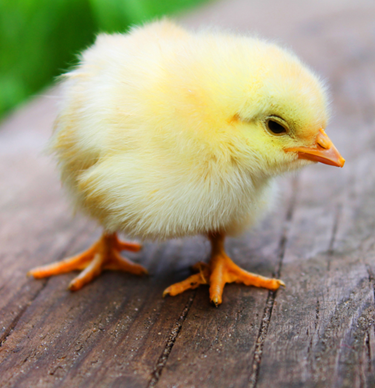
However, we’re just dealing with the embryos so it’s mostly gross bloody alien looking things we’re dealing with.
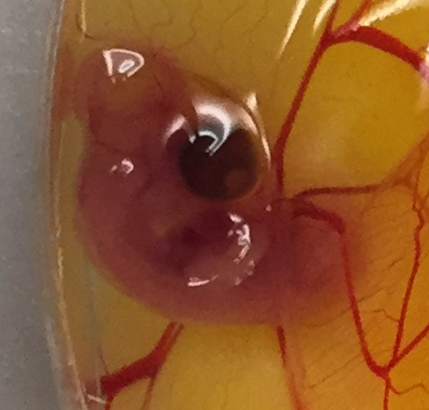
This is a 5 day old chick embryo taken by one of my students. The black circle is it’s eye. Right below it is the heart. The heart beats about twice a minute and the embryo itself moves around quite a bit (mostly twitching at this stage). The blood vessels extend throughout the yolk. I highly recommend you check out this video to see it’s full development.
Observing chick embryos is fairly easy. You can purchase prepared slides online with the embryos at various stages in development (). However, it’s much more interactive for students to observe a live embryo developing in the egg. They can do this through a process called windowing in which they cut a small hole in the shell right next to the embryo. When the shell is removed, you can see the embryo floating in yolk surrounded by blood vessels.
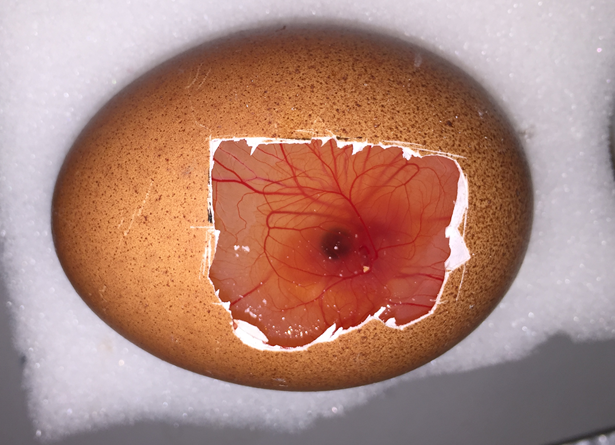
A properly windowed egg. The embryo is a bit obscured by yolk, but you can clearly see the black eye.
You can also see the heart beating in real time. I wanted to make sure my students got a chance to see this so I opted for them to work with live fertilized eggs.
However, In designing this lab, I didn’t simply want students to observe chick embryos. That would result in a lab that’s both short and boring. Instead, I looked online for a simple experiment they could do. One particular website described a lab in which you could use caffeine to modify the heart rate (https://www.swarthmore.edu/NatSci/sgilber1/DB_lab/Chick/caffeinewebpage/onlinelabhandout). I liked the core idea of using drugs to manipulate the chick’s heart rate, but the protocol in that link was pretty terrible. It involved a unnecessary supplies and asked students to rip apart embryos to isolate the heart before doing any measurements. I didn’t know if my chick embryos could withstand that treatment, so I devised a lab that was much more gentle. It involved adding drugs directly on top of embryos while they’re in the egg and seeing what happens. More invasive procedures could then be taken if no effect was seen. This turned out to be a very good idea as the chick embryos we were working with would never have survived that treatment. I also added a second drug option. Students could decide whether to treat embryos with caffeine or ethanol and see how it affects heart rate.
To prepare students for the lab, I had them read a preface to a recent journal issue dedicated to chick embryos (https://www.ncbi.nlm.nih.gov/pubmed/29616717). The reading wasn’t terribly informative, but it was super enthuiastic about the field of studying chick embryos and it achieved it’s purpose of motivating students. I also played a quick video that shows what a developing chick embryo looks like from day 1 to the day it hatches. This served both a motivational purpose (it’s a pretty cool video) but also had instructional merit. I wanted them to understand how far along their own chick were just by looking at them. I also wanted to make sure everyone was on the same page as far as understanding how to open up chick embryos. For that I found and incredibly good instructional video created by MIT the 1972 that was uploaded to Youtube. I cannot emphasize how useful that video was in showing students exactly what to do for creating a window in an egg.
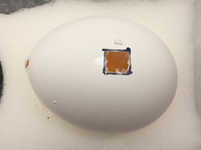
When the lab began, I only had a limited number of fertilized eggs to work with. Eggs can be fragile and I didn’t want my untrained students to break bunch of good eggs trying to learn how to create windows. I decided to buy a bunch of unfertilized eggs at the supermarket and had students practice cutting a hole open with them. This proved to be a very good idea as students made a few errors at first.
The windowing process was pretty easy overall though so few fertilized eggs were lost once they started working on the real thing. Once an egg was windowed, students usually had no trouble finding the embryo and counting heartbeats.
As far as the lab itself, we only ran into a few difficulties. The biggest issue by far was that chick embryos tended to die when not kept at a warm temperature (above 30 oC at least). I didn’t realize this at first, so the first few embryos would just show a decrease in heart rate until they died. Once I figured out it was the temperature, I scrambled to find things to keep the eggs warm (hot plates, slide warmers, etc). I was moderately successful and students got to observe a few embryos have steady heart rates. Caffeine treatment did increase heart rate for some students, but it occasionally caused a heart attack and killed the embryo as well. Ethanol seemed to depress heart rate, but it’s unclear if the effect was due to temperature changes as well. Some students tried taking the embryo out of the shell and onto a petri dish to better observe heart rate and treat with drugs. However, then tended to kill the embryo by stressing it out.
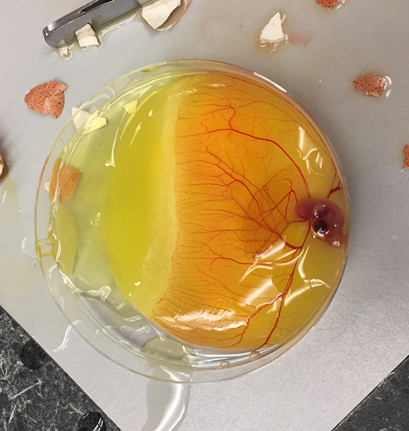
Removing an embryo from the egg helped with visibility, but usually resulted in death.
Overall, I’d call this a successful lab. For anyone who wants to replicate it, the protocol I handed out to students is below.
Handout
BIO320L – Developmental Biology Lab
How drugs affect chick embryo heart rate
Overview
Chick embryos are a common model organism used in developmental biology because they are similar to human embryos, grow quickly, and cheap to produce. In the 1980s, studies showing that drugs affected chick embryo development and physiology began to flourish. Caffeine, was particularly popular because it is commonly injested by pregnant women. Ethanol and Tobacco were also frequently used in these tests for similar reasons. These types of studies still remain an active part of the field. We’re going to replicate some of the early ones showing the effect of caffeine and ethanol on the chick embryo.
Reading
The preface to issue 62 of the International Journal of Developmental Biology explains the importance of chick embroys to the field far better than I can. Read in full.
Link: https://www.ncbi.nlm.nih.gov/pubmed/29616717 or http://www.ijdb.ehu.es/web/descarga/paper/170270cs
Materials
Supermarket Eggs
Fertilized Eggs
Dissecting tools (scapels, scissors, tape)
Extra tools (cups, spoons, saran wrap)
PBS
Caffeine
Ethanol
Protocol
Practice:
1) For each group, take several
supermarket eggs.
2) Practice opening up these eggs
without damaging the yolk.
a. The egg should be secured with the
wide end facing up
b. A 1 cm X 1 cm section of the shell
should be removed
c. It may help to apply tape around the
piece of shell being removed
3) Save the yolk in a separate
container. Try to keep yolk away from
the albumen
4) Repeat until every student has a
chance to practice and you succeed at least once.
Preparation:
1)
Create
a 1 mg/mL caffeine solution with caffeine and PBS
2)
Create
a 20% ethanol solution with ethanol and PBS
Application:
1. Each
group should take one hybridized egg at a time
2. Create
a window and confirm whether or not an embryo is within.
3. Try
to record the heart rate of the embryo while it is still in the egg. For each heart rate determination, count the
number of beats in 15-60 second intervals at least three times.
Numerous factors can influce the heart rate. Temperature, removal of the embryo, physical shaking, etc. We’re going to try applying caffeine or ethanol with minimal levels of intervention at first
4. Choose either caffeine or ethanol to test first. Use a pipette to remove a small amount of yolk near the embryo without disturbing the embryo.
5. Try adding an equivalent volume the drug mixture as close to the embryo as possible while still being able to see the embryo heart beat.
6. Incubate the egg at 37 oC for at least 15 minutes to let the drugs diffuse
7. Record the heart rate
Extraction of the embryos:
8. (html comment removed: [endif])If no change is seen, we can try extracting the embryo from the egg and putting it in a petri dish
9. Using a spoon, remove the embryo from the egg and place it in a petri dish, saran wrap, or plastic cup
10. Apply drug mixture, wait 15 minutes and record heart rate
Removal of the heart:
11. (html comment removed: [endif])If no change is seen, we can remove the heart from the embryo itself. Let’s hope it doesn’t come down to this.
12. Using the fine forceps, remove the trunk region of the embryo above and below the heart.
13. Remove the heart region, leaving the heart intact and place the heart in a yolk/drug mixture
14. Wait 15 minutes and record heart rate
Nice pic 👍
Posted using Partiko Android
Thanks!
Nice article.
But a word about formatting. It looks fine in steemstem.io
But in steemit there are lot issues. Maybe you should check it.
Wow you're not kidding. I guess I got a bit overzealous with the floaty pics. I'll go through and make it as legible as possible on both platforms. Thanks for the heads up!
the html issues are fine now. only the image thing is left.
Yeah, I just had to abandon SteemStem's ability to float images within text and keep everything simple. It looks pretty good on steemstem and acceptable on steemit and that's good enough for me. Thanks again for the help.
Excellent post. I’ve been following you. I have been using Steemit to disseminate the Unpublished Data on my backups after I retired from scientific research. I have lots of lab tips, a few already posted. I have some posts planned, but I am getting old data with old software on old computers, which is posing a challenge.
Thanks! Looking forward to reading some of your unpublished data. Steemit is a great platform to release it.
Fascinating. It looks almost similar to our fundus which kinda creepy at the same time.
I had to google fundus to figure out what it was (the back of an eye). You're right, the resemblance is uncanny!
Nice stuff! Thank you!
Regards
Chapper
Thanks man. It's not advanced science, but leaning how to run these labs has been a blast!
Science starts with little steps!
Good work
This post has been voted on by the SteemSTEM curation team and voting trail. It is elligible for support from @curie and @utopian-io.
If you appreciate the work we are doing, then consider supporting our witness stem.witness. Additional witness support to the curie witness and utopian-io witness would be appreciated as well.
For additional information please join us on the SteemSTEM discord and to get to know the rest of the community!
Thanks for having added @steemstem as a beneficiary to your post. This granted you a stronger support from SteemSTEM.
Thanks for having used the steemstem.io app. You got a stronger support!
Couldn't do any of this without SteemSTEM!
Hi @tking77798!
Your post was upvoted by Utopian.io in cooperation with @steemstem - supporting knowledge, innovation and technological advancement on the Steem Blockchain.
Contribute to Open Source with utopian.io
Learn how to contribute on our website and join the new open source economy.
Want to chat? Join the Utopian Community on Discord https://discord.gg/h52nFrV
Thanks!
Congratulations @tking77798! You received a personal award!
You can view your badges on your Steem Board and compare to others on the Steem Ranking
Vote for @Steemitboard as a witness to get one more award and increased upvotes!